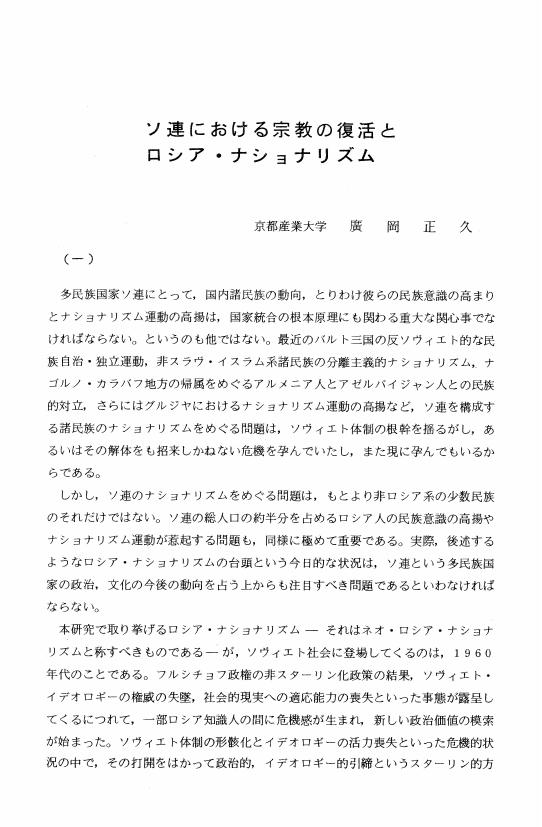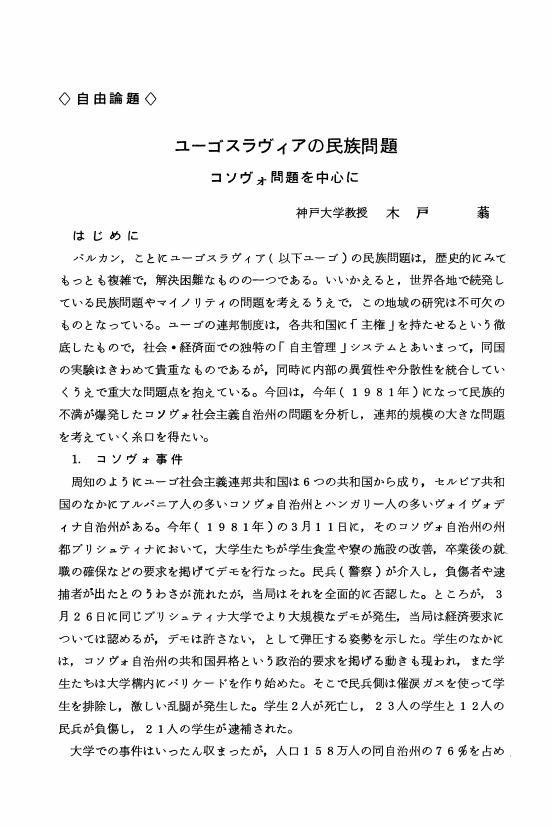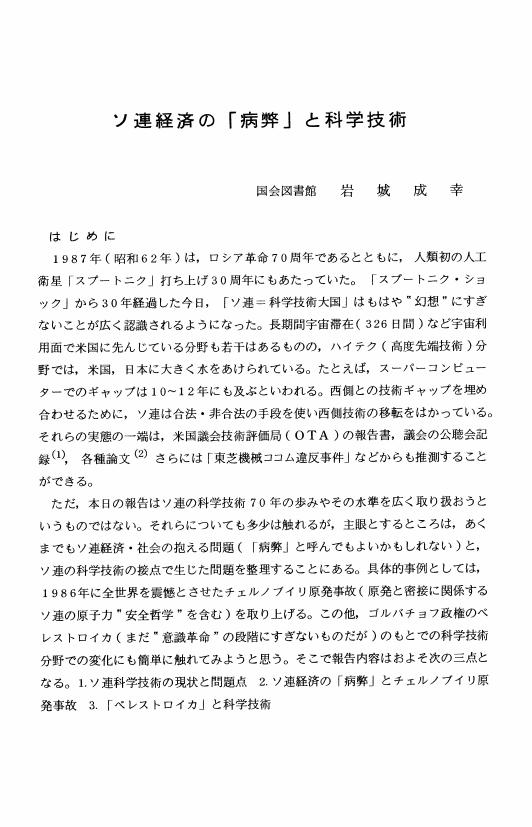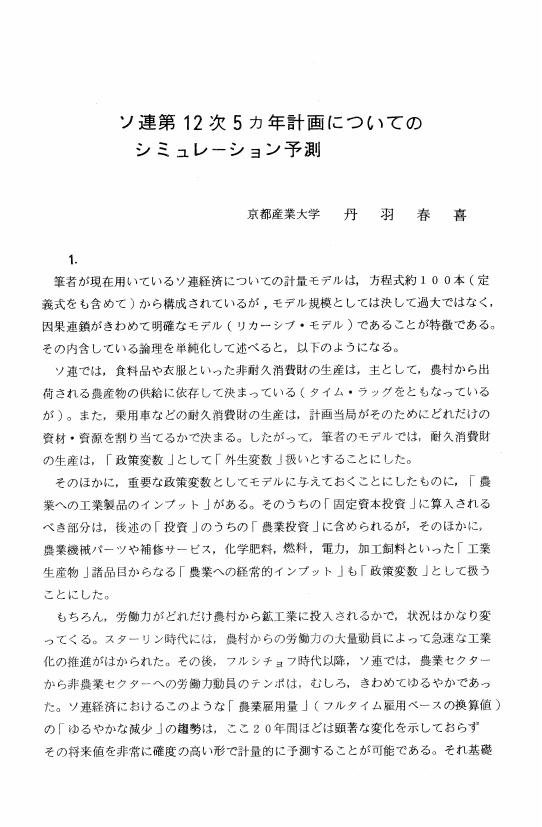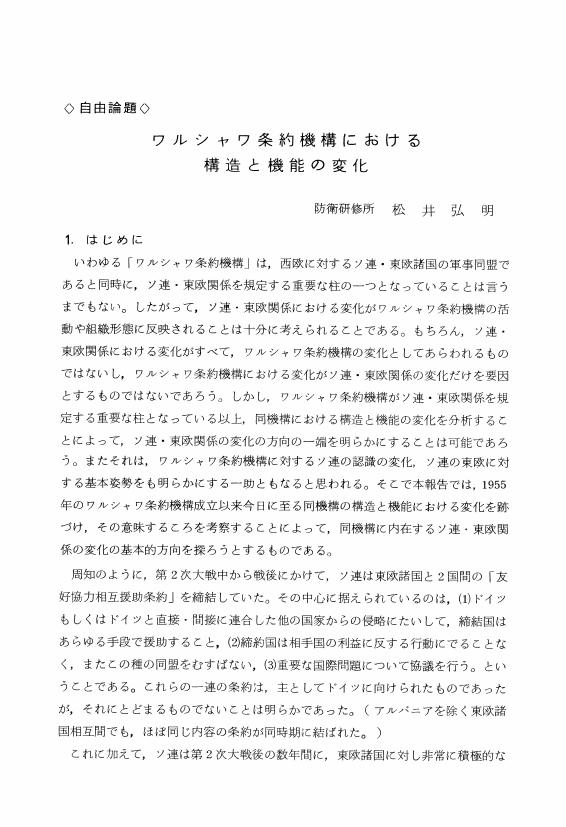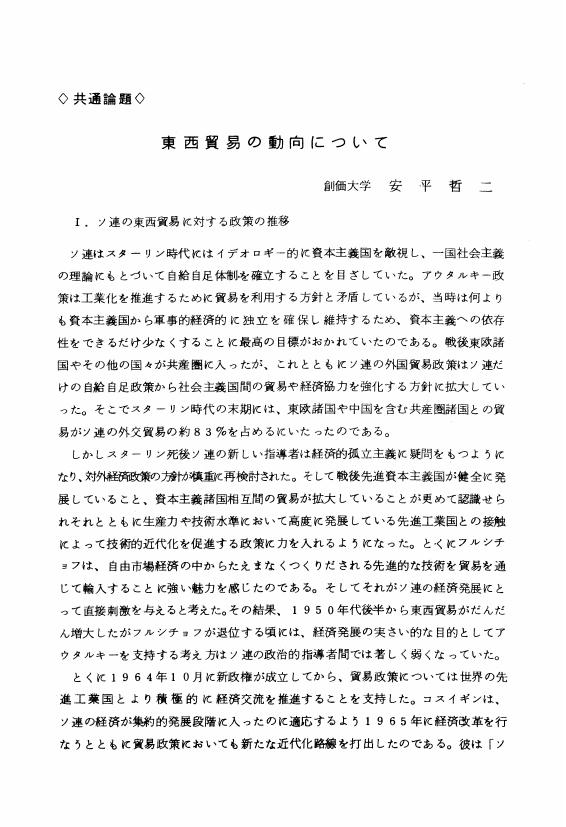291 0 0 0 OA 初期ソビエトにおける家族消滅論と自由恋愛論
- 著者
- 森下 敏男
- 出版者
- THE JAPANESE ASSOCIATION FOR RUSSIAN AND EAST EUROPEAN STUDIES
- 雑誌
- ソ連・東欧学会年報 (ISSN:03867226)
- 巻号頁・発行日
- vol.1981, no.10, pp.90-101, 1981 (Released:2010-03-16)
- 参考文献数
- 1
21 0 0 0 OA ロシアの出生率の改善要因
- 著者
- 田畑 朋子
- 出版者
- The Japanese Association for Russian and East European Studies
- 雑誌
- ロシア・東欧研究 (ISSN:13486497)
- 巻号頁・発行日
- vol.2010, no.39, pp.93-101, 2010 (Released:2012-06-20)
- 参考文献数
- 14
- 被引用文献数
- 1
10 0 0 0 OA プーチン政権下における「愛国主義」政策の変遷
- 著者
- 西山 美久
- 出版者
- The Japanese Association for Russian and East European Studies
- 雑誌
- ロシア・東欧研究 (ISSN:13486497)
- 巻号頁・発行日
- vol.2010, no.39, pp.82-92, 2010 (Released:2012-06-20)
This paper traces the changing course of the patriotic policies of Putin’s government, and shows that the ‘color revolutions’ in Georgia, Ukraine and Kyrgyz had a great impact on the Russian political process. Post-communist Russia has suffered from serious political and economic disturbances, comparable with smuta in tsarist Russia. In the first period of the New Russia, while Yeltsin’s government adopted a series of western-oriented policies, the opposition put forward an alternative line based on Russian nationalism. As Russian citizens displayed anti-western sentiments, however, president Yeltsin also changed course and modified policies to take national feelings into consideration. As a result, almost all political forces in Russia became proponents of Russian patriotism. Therefore, we need to examine the real contents of the patriotism held by political forces, particularly in each administration. President Putin, who followed president Yeltsin in 2000, stressed the importance of patriotism in his policies. Valerie Sperling, who analyzed patriotic policies in post-Soviet Russia, argues that Putin practiced various policies based on ‘militarized patriotism’ toward Russian youth, because his government needed to foster their loyalty to the state and their interest in joining the Russian army. Although I agree with her claim that Putin pursued patriotic policies, Sperling appears not to have grasped a turning point in policy transformation under Putin, in particular the real meaning of the ‘color revolutions’ that took place in the former Soviet Republics in 2003–2005. This paper analyzes the two programs for promoting patriotism among Russians, each of which was adopted under Putin’s government in 2001 and 2005. The difference between both programs is that the first was directed at all social and age groups, while the second mainly targeted the younger generation. Why did the latter program focus on youths? This paper examines the political impact on Putin’s administration of the ‘color revolutions’ in the CIS countries in which the younger generation played a significant role, and clarifies Putin’s efforts to prevent these revolutions from spilling over into Russia, through organizing a new youth organization named ‘Nashi,’ publishing a new edition of the guidebook for teaching Russian history, and other efforts.
8 0 0 0 OA ソ連企業従業員の行動
- 著者
- 宮本 勝浩
- 出版者
- THE JAPANESE ASSOCIATION FOR RUSSIAN AND EAST EUROPEAN STUDIES
- 雑誌
- ソ連・東欧学会年報 (ISSN:03867226)
- 巻号頁・発行日
- vol.1987, no.16, pp.59-68, 1987 (Released:2010-03-16)
- 参考文献数
- 18
7 0 0 0 OA ソ連における宗教の復活とロシア・ナショナリズム
- 著者
- 廣岡 正久
- 出版者
- THE JAPANESE ASSOCIATION FOR RUSSIAN AND EAST EUROPEAN STUDIES
- 雑誌
- ソ連・東欧学会年報 (ISSN:03867226)
- 巻号頁・発行日
- vol.1988, no.17, pp.23-32, 1988 (Released:2010-03-16)
7 0 0 0 OA 断片化するリトアニア政党システム
- 著者
- 中井 遼
- 出版者
- The Japanese Association for Russian and East European Studies
- 雑誌
- ロシア・東欧研究 (ISSN:13486497)
- 巻号頁・発行日
- vol.2009, no.38, pp.89-103, 2009 (Released:2011-10-14)
This article presents quantitative aspects of the party system in Lithuania and argues that Lithuania’s electoral institutions (mixed-member majoritarian system) define the quantitative features of its party system. There has been an ambivalent view of Lithuanian party politics in the literature. Some scholars argue that it is a highly fragile and volatile system, while others assert that it is stable. Several scholars have argued that its complexity could be explained as a result of intertemporal change. Adding to this debate, I argue that the differing evaluations of the Lithuanian party system is the result of analyses based on different measurement scores. The view that the system is unstable is supported by the multitude of political parties that seats in the parliament and the view that it is volatile is evidenced by the fact that newcomer parties easily win seats. On the other hand, effective party number index (known as the Laakso-Taagepera index) and the bipolar cabinet forming support the view that the system is stable. This article organizes and clears up various quantitative features of the party system of Lithuania and argues that its two main aspects—its instability (multitude of political parties) and its volatility (newcomer parties)—are prominent features of the political systems in other Central and East European countries. In order to explore the origins of these two prominent aspects of the Lithuanian party system, this article focuses on Lithuania’s electoral institutions. Socioeconomic and historical factors cannot account for the quantitative aspects of Lithuanian party politics. Lithuania has adopted the mixed-member majoritarian system as their electoral system, an institution that is very exceptional in the context of the Central and East European democracies. Referring to theoretical research in electoral studies, I argue that Lithuania’s adaptation of the mixed-member system is an explanatory variable in the determination of the quantitative aspects of Lithuania’s party system. This is because Lithuania’s adaptation of the mixed-member system, including single member district, do not promotes two party systems, rather fragmentizes the party system and foments personal voting. These effects are bolstered by contamination effects which occur in the mixed-member majoritarian system, seats distribution rule and the transitional fledgling Lithuanian party system. Observation clearly shows that single-member districts are responsible for the multitude of political parties, which are seated in the Lithuanian parliament. Representatives from about four to six parties are elected in proportional representation districts, but representatives from ten parties are elected in single member districts in Lithuania. Moreover, profiles of political elites who organize new political parties show that those who have been elected in single member districts are significantly involved in splitting from existing parties and forming new political parties. In addition, in single member districts it is easier for a member of the local elite possessing a political or economic power base to win an election than in another type of district. Lithuania’s party politics exhibit aspects of both stability and instability. However, the quantitative character and prominent features of the party system have been considerably defined by its mixed-member majoritarian electoral system.
3 0 0 0 OA ソビエト女性の政治的地位
- 著者
- 宇多 文雄
- 出版者
- THE JAPANESE ASSOCIATION FOR RUSSIAN AND EAST EUROPEAN STUDIES
- 雑誌
- ソ連・東欧学会年報 (ISSN:03867226)
- 巻号頁・発行日
- vol.1978, no.7, pp.98-111, 1978 (Released:2010-03-16)
- 参考文献数
- 6
- 被引用文献数
- 1 1
3 0 0 0 OA 〈パネルディスカッション〉 歴史の中の体制転換
- 著者
- 塩川 伸明 柴 宜弘 田口 雅弘 望月 哲男
- 出版者
- The Japanese Association for Russian and East European Studies
- 雑誌
- ロシア・東欧研究 (ISSN:13486497)
- 巻号頁・発行日
- vol.2010, no.39, pp.26-56, 2010 (Released:2012-06-20)
3 0 0 0 :―ソ連型母性主義と「子だくさんの母」を中心に―
- 著者
- 光吉 淑江
- 出版者
- The Japanese Association for Russian and East European Studies
- 雑誌
- ロシア・東欧研究 (ISSN:13486497)
- 巻号頁・発行日
- no.34, pp.133-145, 2005
This article examines how Soviet maternalist policies were implemented in Western Ukraine, a newly acquired Soviet territory in the wake of the Second World War. While the 1944 Soviet Family Code, especially the campaign for "Mothers with Many Children, " has often been seen as the culmination of the Stalinist pronatalist policies-virtually encouraging extramarital affairs in order to produce children-, its meaning, perception, and methods of implementation were not uniform even in the authoritarian Soviet society. A close examination of the archival documents on the newly created women's departments in the Western Ukrainian party committees reveals that the "Mothers with Many Children" campaign and other state maternal supports served to justify otherwise extremely unpopular Soviet policies in the region. The essentialized gender role of "mother" was a rare measure of Sovietization that did not require special skills, training, or political education, and therefore would not have caused much resistance, bloodshed, or even hesitation. The Western Ukrainian women often quickly learnt how to exercise their new rights in defence of their lives in order to survive the difficult postwar material situation, thus becoming important, if not active, agents in the establishment of the Soviet regime in the region.
2 0 0 0 OA ユーゴスラヴィアの民族問題
- 著者
- 木戸 蓊
- 出版者
- THE JAPANESE ASSOCIATION FOR RUSSIAN AND EAST EUROPEAN STUDIES
- 雑誌
- ソ連・東欧学会年報 (ISSN:03867226)
- 巻号頁・発行日
- vol.1981, no.10, pp.102-114, 1981 (Released:2010-03-16)
- 参考文献数
- 15
2 0 0 0 OA 対ソ経済制裁をめぐる西側世界内部の矛盾
- 著者
- 山本 武彦
- 出版者
- THE JAPANESE ASSOCIATION FOR RUSSIAN AND EAST EUROPEAN STUDIES
- 雑誌
- ソ連・東欧学会年報 (ISSN:03867226)
- 巻号頁・発行日
- vol.1983, no.12, pp.2-11, 1983 (Released:2010-03-16)
2 0 0 0 OA ソ連経済の 「病弊」 と科学技術
- 著者
- 岩城 成幸
- 出版者
- THE JAPANESE ASSOCIATION FOR RUSSIAN AND EAST EUROPEAN STUDIES
- 雑誌
- ソ連・東欧学会年報 (ISSN:03867226)
- 巻号頁・発行日
- vol.1987, no.16, pp.20-32, 1987 (Released:2010-03-16)
- 参考文献数
- 41
- 被引用文献数
- 1
2 0 0 0 OA 移民大国ロシアの軌跡
- 著者
- 堀江 典生
- 出版者
- The Japanese Association for Russian and East European Studies
- 雑誌
- ロシア・東欧研究 (ISSN:13486497)
- 巻号頁・発行日
- vol.2010, no.39, pp.13-25, 2010 (Released:2012-06-20)
- 参考文献数
- 36
This paper examines how Russia has addressed a series of migration issues since the collapse of the Soviet Union. To follow the history of Russia’s migration issues, we examine legislative and institutional changes, and the academic trends of Chinese migration issues in Russia, and analyze the labor market structure where Central Asian migrant workers are embedded. Finally we examine how to define the problems faced by foreign workers in the labor market in a migration study of Russia. The problems faced by the former Soviet countries after the collapse of the Soviet Union included how each country would manage the newly established borders and how they would control the human and commodity flows through them. In the early 1990s, Russia originally had to tackle how to receive ethnic Russians living in the former Soviet Union, how to resettle them, and how to control their increased flow. The revised law on forced migration in 1995 decreased the number of forced migrants from the former Soviet Union to Russia, and in turn a massive flow of Chinese migrants to Russia, especially to the Russian Far East, became the center of public attention. The Russian public and government considered the increasing numbers of Chinese migrant workers a threat to Russia and often dubbed such immigration the “yellow peril.” However, recent academic research on Chinese migration studies in Russia tends to draw a clear line against such alarmist discourse and to explore the realistic features of Chinese migrants living and working in Russia. Such research showed that most Chinese migrant workers are traders and businessmen temporarily staying in Russia and are actively exploring business opportunities and creating employment. Chinese migrant workers are indispensable for the Russian Far East where the labor shortage is critical. But in general, Chinese migrant workers find jobs, not due to the traditional demand of Russia’s labor market, but due to the demand created by Chinese businesses. The recent majority of foreign workers are from Central Asia. They are allowed to cross Russia’s border without visas and to look for jobs without visas or work permits. Central Asian workers living in Russia are embedded in the Russian labor market and occupy unqualified and low-paid jobs at the bottom of the market, filling jobs Russians do not want. Central Asian workers are employed with the traditional demand that Russia’s society always requires. Russia cannot maintain her economy and daily life without Central Asian workers. The Russian government, however, still fails to establish good governance to allow them to work legally, doesn’t protect their human and labor rights, and doesn’t ease the vulnerability they face as foreign workers. Migrant workers face much trouble in their daily lives and bureaucratic barriers to obtain legal status to stay and work in Russia. Without protecting their human and labor rights, the establishment of a common labor market in Eurasia, which is often mentioned in Russia, remains far from realization. Therefore we must scrutinize the real features of foreign workers in Russia’s labor market and tackle the problems faced by foreign workers in Russia.
2 0 0 0 OA 18世紀前半における軍隊とロシア貴族
- 著者
- 田中 良英
- 出版者
- The Japanese Association for Russian and East European Studies
- 雑誌
- ロシア・東欧研究 (ISSN:13486497)
- 巻号頁・発行日
- vol.2009, no.38, pp.72-88, 2009 (Released:2011-10-14)
In order to understand concretely how the Russian Imperial government used the nobility in state service in the 18th century, it is necessary to investigate the actual conditions in the army, because many noblemen were firstly recruited into the army and trained there as state servants. Once temporarily established under the reign of Peter I only for the coronation ceremony of his Empress Catherine on 8 May, 1724, the Cavalry Guards (Kavalergardy) were reformed as a permanent military unit by Catherine I at the end of 1725. This corps has two noteworthy features. Firstly, unlike the other two existing guard regiments that included soldiers and officers who were recruited from the common people, it was composed exclusively of both Russian and foreign noblemen, most of whom started state service as common soldiers or dragoons and attained the status of company officers on the basis of their continuous work and abilities. Being appointed to the Cavalry Guards was rather beneficial for these military functionaries, because they were frequently and quickly promoted to a higher rank either while in office or at the transfer to different posts despite not being expected to actually fight on the battlefield. After leaving the Cavalry Guards, some of the members became core commanders of the two guard regiments newly founded under Anna Ioannovna in 1730, and others reached the top four ranks in the Russian army or the administrative system. Along with these high-ranking officials, many of the ex-cavalrymen were promoted to offices leading regiments, battalions, or local governments, acquiring grades equal to field officers. Judging from such social origins and career patterns of the staff, the Cavalry Guards can be seen one of the important resources for the Imperial government to gather and organize the talented and experienced noblemen distributed across the vast Empire, thereby utilizing their abilities not only in military but also in civil organs. Furthermore, this unit played a social role in absorbing and posting serviceable foreign families into Russia. The second important point is that the Cavalry Guards were mainly used in the Westernized court and state ceremonies, which were employed by the Russian rulers, especially after the Petrine reform, to propagate their unrivalled authority both in- and outside Russia. For example, at the coronation of Empress Catherine in the Moscow Kremlin, the cavalrymen in white wigs, hats with gold lace and white ribbons, green woollen coats, and red woollen vests guarded both the front and the rear end of the procession of the Empress and her husband when they paraded from the court to the ceremonial cathedral. Contributing greatly to the glorification of the rituals and monarchical power, such colourful costumes attracted considerable attention from contemporaries, above all, the foreign diplomats, one of whom noted their resemblance to the uniforms of the French musketeers (mousquetaire). Additionally, soon after Anna’s arrival at the outskirts of Moscow and at a relatively early stage of her coronation, the Cavalry Guards were granted a special audience with her, which symbolically suggested the respectful treatment of the rulers. Such favour could also have strengthened the connections between the imperial power and the elite, thereby supporting the rapid development of the 18th-century Russian Empire.
2 0 0 0 OA ロシア革命70周年とソ連の軍事政策
- 著者
- 長谷川 毅
- 出版者
- THE JAPANESE ASSOCIATION FOR RUSSIAN AND EAST EUROPEAN STUDIES
- 雑誌
- ソ連・東欧学会年報 (ISSN:03867226)
- 巻号頁・発行日
- vol.1987, no.16, pp.1-12, 1987 (Released:2010-03-16)
2 0 0 0 OA ソ連第12次5カ年計画についてのシミュレーション予測
- 著者
- 丹羽 春喜
- 出版者
- THE JAPANESE ASSOCIATION FOR RUSSIAN AND EAST EUROPEAN STUDIES
- 雑誌
- ソ連・東欧学会年報 (ISSN:03867226)
- 巻号頁・発行日
- vol.1986, no.15, pp.51-69, 1986 (Released:2010-03-16)
2 0 0 0 OA ソ連と朝鮮半島
- 著者
- 高瀬 浄
- 出版者
- THE JAPANESE ASSOCIATION FOR RUSSIAN AND EAST EUROPEAN STUDIES
- 雑誌
- ソ連・東欧学会年報 (ISSN:03867226)
- 巻号頁・発行日
- vol.1985, no.14, pp.14-24, 1985 (Released:2010-03-16)
2 0 0 0 OA 軍事的バランスよりみたソ連の政治的意図
- 著者
- 関野 英夫
- 出版者
- THE JAPANESE ASSOCIATION FOR RUSSIAN AND EAST EUROPEAN STUDIES
- 雑誌
- ソ連・東欧学会年報 (ISSN:03867226)
- 巻号頁・発行日
- vol.1981, no.10, pp.60-75, 1981 (Released:2010-03-16)
2 0 0 0 OA ワルシャワ条約機構における構造と機能の変化
- 著者
- 松井 弘明
- 出版者
- THE JAPANESE ASSOCIATION FOR RUSSIAN AND EAST EUROPEAN STUDIES
- 雑誌
- ソ連・東欧学会年報 (ISSN:03867226)
- 巻号頁・発行日
- vol.1980, no.9, pp.68-78, 1980 (Released:2010-03-16)
- 参考文献数
- 16
2 0 0 0 OA 東西貿易の動向について
- 著者
- 安平 哲二
- 出版者
- THE JAPANESE ASSOCIATION FOR RUSSIAN AND EAST EUROPEAN STUDIES
- 雑誌
- ソ連・東欧学会年報 (ISSN:03867226)
- 巻号頁・発行日
- vol.1978, no.7, pp.31-55, 1978 (Released:2010-03-16)
- 参考文献数
- 11
- 被引用文献数
- 6 1



